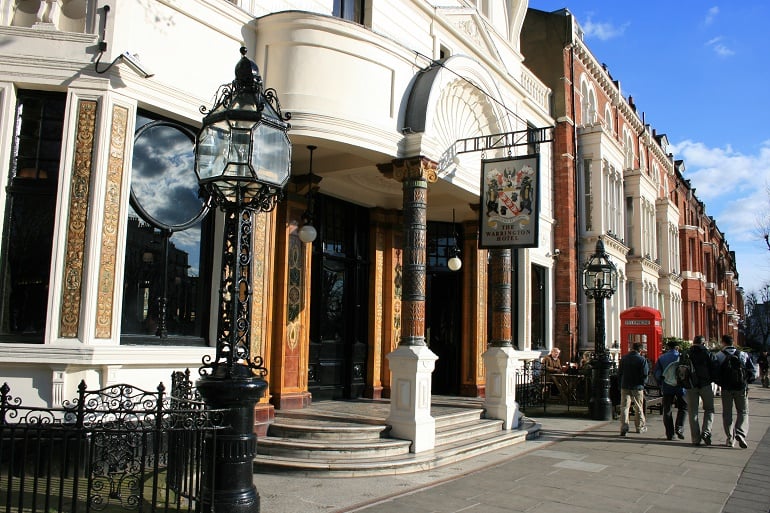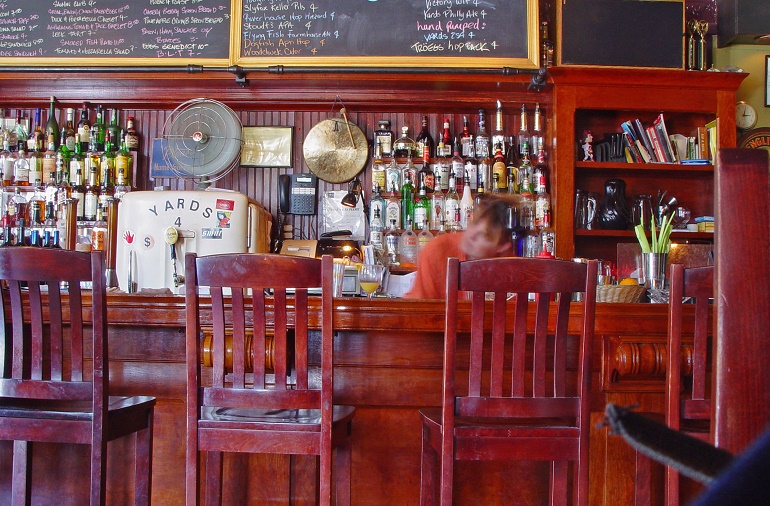Start 14-Day Trial Subscription
*No credit card required

Bettering Beer and Food: The Rise of the Gastropub
Entering the Warrington, a pub in London’s mostly residential Maida Vail district, forewarns of nothing particularly astonishing. Sure, it is gorgeous in the way that most restored Victorian pubs are, but frankly the British capital is full of such places. And while the beer selection is quite nice, featuring casks from Fuller’s and Adnams and bottles from Meantime and Young’s, there are plenty of pubs in Westminster alone that offer better selections.
 So the average visitor might order a well-kept pint at the ornate bar, admire the mosaic tile floor and Art Nouveau friezes, and conclude that all was good with the world, if not extraordinary. Until he got hungry and ordered some food. Then, the universe of the Warrington would slowly unfold.
So the average visitor might order a well-kept pint at the ornate bar, admire the mosaic tile floor and Art Nouveau friezes, and conclude that all was good with the world, if not extraordinary. Until he got hungry and ordered some food. Then, the universe of the Warrington would slowly unfold.
It would begin when a fine-looking ploughman’s lunch or a chicken and wild mushroom pie, unfussily adorned by a rounded scoop of mashed potato, arrived at his table. He would take an absent-minded bite and respond with a raised eyebrow. A second bite would inspire greater interest, while a third might bring about something approaching gastronomic rapture. And that’s when he would realize that he was in some place special.
Except that he’s not. For despite its impressive pedigree – the Warrington is part of Gordon Ramsay’s pub holdings and the food reflects the star chef’s standing – in today’s London, or even today’s United Kingdom, a pub with good or even excellent food is hardly the rarity it once was.
To the great relief and profound appreciation of pubgoers everywhere, it is now possible to dine well in an English, Scottish or Welsh public house. Not all of them, of course, or even most, but enough that it need not be a trial to find a decent pint and a good meal in the same place.
For this, we have the Eagle to thank.
While it is debatable as to whether the Eagle, in the Clerkenwell area of central London, was founded more in appreciation of the harmonies that exist between good beer and fine food or as an opportunistic way to wring new life out of a moribund pub, there is broad consensus that the unassuming enterprise is the sire of the modern English gastropub movement. The facilitators were David Eyre and Mike Belben, who in 1991 took possession of a down-at-the-heels pub, installed a make-shift kitchen behind one end of the bar and began dispensing a menu of market-driven cuisine alongside cask ales and a radically improved selection of wines.
The newly defined gastropub was an almost immediate success, which naturally enough spawned a veritable bevy of imitators, to the point that you don’t have to look long at British beer or food online chatrooms these days to find someone complaining about the overabundance of such places. But what is often overlooked in such screeds is the corollary effect the emergence of the gastropub has had on non-“gastro” pub fare.
While it is true, or at least a defensible, to say that some gastropubs have taken the concept entirely too far, turning what should be relatively simple and straightforward food into complex structures of parmesan towers, house-cured meats and parsley foam, it’s equally valid to suggest that the Eagle and its imitators have helped elevate the general quality of pub dining across the U.K., from Portsmouth to Aberdeen.
Take the Warrington’s chicken and wild mushroom pie, for example, which, despite its evident simplicity, was pronounced by my dining companion on one recent visit to be the finest he had ever tasted. Or the grilled venison – okay, Linkenholt Estate Roe deer – and roasted beet salad at west London’s Harwood Arms. Or the excellent “full English” breakfast at the Fox & Anchor, also in Clerkenwell, which has spacious and comfortable rooms to let on the floors above. Each is a stellar example of basic, traditional pub food executed to near perfection, and each is equally and entirely without pretention.
All this amounts to a resurrection of the understanding that beer and food belong together, and that a proper pub will serve not just quality ale but also proper food. It is how the nation developed its cuisine in the first place, from dishes born in the public house, and why the beer styles that evolved to typify British brewing, like best bitter and porter, just happen to be ones complementary to so-called “pub grub” dishes, like steak and kidney pie and fish and chips.
Best of all, like The Beatles, pale ale and Pop Idol, it’s a belief that has begun to sweep across North America.
 While it is difficult to precisely identify our continent’s version of the Eagle, a strong case could be made in favor of Philadelphia’s Standard Tap, opened in 2000 by the business partners William Reed and Paul Kimport. According to Reed, the decision to include an ever-changing, chalkboard menu of well-above-average bar fare was simple common sense.
While it is difficult to precisely identify our continent’s version of the Eagle, a strong case could be made in favor of Philadelphia’s Standard Tap, opened in 2000 by the business partners William Reed and Paul Kimport. According to Reed, the decision to include an ever-changing, chalkboard menu of well-above-average bar fare was simple common sense.
“For us, it happened organically,” said Reed. “We had never even heard the word ‘gastropub’ when we were building the Tap, but it seemed logical to Paul and I that you’d want good food with good beer. Besides, the people we knew who were into beer also appreciated quality cuisine.”
However, while there is no belittling the Standard Tap’s food credentials, you would need to stretch the definition of “pub” a long way in order to assign it to the dark, bare-bones tavern. For a more faithful homage to the British gastropub, head a little north to the island of Manhattan and the Spotted Pig, the place most often identified by the (mostly New York-based) media as the progenitor of the North American gastropub.
Opened to great fanfare in 2004 – largely, one suspects, because of the early involvement of Mario Batali – the Greenwich Village pub combines the ambiance of a pub, albeit a New World version, with cask-conditioned ales, a decent if sparse tap and bottle list, and, pivotally, dishes conceived and executed by the chef, April Bloomfield, who one suspects has more than a passing familiarity with pub food, being an alumnus of London’s River Café. But still, at $26 for a plate of veal kidney, these aren’t exactly pub prices.
Toronto’s beerbistro, in which this author has a small ownership stake, is another place where beer and food come deliciously together, in its case quite literally. The specialty of the house at the downtown restaurant is beer cuisine, and ale or lager figures in a large number of the dishes, from bread raised with a sourdough culture harvested from bottles of Cantillon lambic to beer-based ice creams. In its case, however, both price and atmosphere are significantly un-pub-like.
Elsewhere the popularity of good beer and great food continues to grow, whether in a reconditioned storehouse like that housing Chicago’s much talked about beer restaurant, the Publican, or on an unremarkable corner in San Francisco’s infamous Haight-Ashbury neighborhood, as with the Magnolia Gastropub and Brewery. Be it elevated bar fare, like the mixed meat Shepherd’s Daughter’s Pie at Atlanta’s Brick Store Pub, or a Belgian-inspired meal at Seattle’s Brouwer’s Café, a single location bar or a multi-unit franchise like the Gordon Biersch Brewery Restaurant chain, word has gone out and notice is being paid: at the table, beer does belong.
And, it might well be added, not before time.
PUB GRUB
Eager to try your hand at crafting some top-notch pub fare?
Here are a couple of recipes to get you started.
Mussels and Bacon Cooked in Cider
From “Gordon Ramsay’s Great British Pub Food” (Harper Collins, 2009)
Serves 4
• 2 kg (4.4 lbs) live mussels
• 1 tbsp olive oil
• 150 g (5.5 oz.) piece of bacon, cut into 3 to 4 pieces
• 5 to 6 garlic cloves (unpeeled), halved
• A few thyme sprigs
• 100 ml (3.5 oz.) dry cider
• Black pepper
• Handful of flat-leaf parsley, leaves only, chopped
Scrub the mussels, removing their beard and discarding any that are open and do not close when tapped. Set aside.
Heat the olive oil in a large, heavy-based pan. When hot, add the bacon and fry, turning, for 4 to 5 minutes until it has released most of its fat and is golden brown all over. Add the garlic and thyme and fry for another minute.
Tip in the mussels and pour in the cider. Cover with a tight-fitting lid and give the pan a gentle shake. Steam the mussels over a medium-high heat for 3 to 4 minutes until they have opened.
Remove the pan from the heat and grind over some black pepper. Taste the juices for seasoning; you probably won’t need to add extra salt as the bacon and mussels should provide enough. Pick out and throw away any mussels that have not opened. Sprinkle with chopped parsley and serve immediately, remembering to provide spare bowls for the discarded mussel shells.
Ale-Braised Veal Cheeks
From “The beerbistro Cookbook” (Key Porter Books, 2009)
Serves 8
• 5 lbs (2.25 kg) veal cheeks
• Pinch salt and freshly ground black pepper
• 1/2 cup (125 mL) oil
• 6 sprigs fresh thyme, leaves removed and stems discarded
• 2 sprigs fresh rosemary, leaves removed and stems discarded
• 2 to 3 juniper berries
• 3 cloves garlic
• 2 cups (500 mL) light to medium bodied brown ale
• 1 tbsp (15 mL) red wine vinegar
• 4 1/2 cups (1.125 L) veal stock
Season veal cheeks well with salt and pepper. Preheat oven to 275 degrees.
In a large, deep, heavy-bottomed frying pan over medium-high heat, heat oil until very hot but not smoking. Add veal cheeks and brown on all sides.
Remove meat from the pan and drain excess oil. Reduce heat to medium and return cheeks to the pan along with rosemary, thyme, juniper berries, garlic, beer and vinegar.
In a separate medium saucepan, bring veal stock to a boil and pour over cheeks.
Cover the pan with a lid or foil and continue to cook in the oven for six hours or until a knife passes easily through the cheeks.
Remove cheeks from the pan and set aside. Pass liquid through a strainer to remove solids. Skim if necessary.
Return liquid to the pan over medium-high heat and reduce until it thickens and lightly coats the back of a spoon. Reduce heat and return cheeks to sauce. Heat gently until cheeks are warmed through.
Serve over mashed potatoes or sweet potato mash with seasonal vegetables, or over ravioli or other pasta in a butter or light cream sauce.




Comments